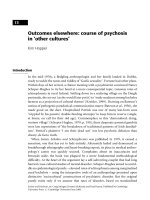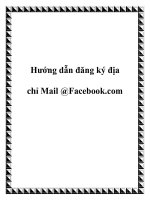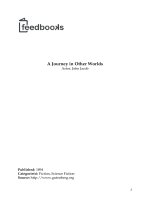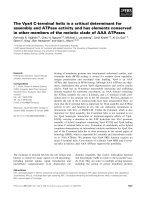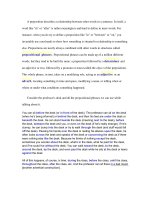In other words facebook com lingualib
Bạn đang xem bản rút gọn của tài liệu. Xem và tải ngay bản đầy đủ của tài liệu tại đây (2.82 MB, 392 trang )
facebook.com/LinguaLIB
In Other Words
In Other Words has been the definitive coursebook for students studying translation
for nearly three decades. Assuming no knowledge of foreign languages, it offers
a practical guide based on extensive research in areas as varied as lexis, grammar,
pragmatics, semiotics and ethics. It thus provides a solid basis for training a new
generation of well-informed, critical students of translation.
Drawing on linguistic theory and social semiotics, the third edition of this
best-selling text guides trainee translators through the variety of decisions they
will have to make throughout their career. Each chapter offers an explanation
of key concepts, identifies potential sources of translation difficulties related to
those concepts and illustrates various strategies for resolving these difficulties.
Authentic examples of translated texts from a wide variety of languages and
genres are examined, and practical exercises and further reading are included at
the end of each chapter.
The third edition has been fully revised to reflect recent developments in the
field and includes a new chapter that engages with the interplay between verbal
and visual elements in genres as varied as children’s literature, comics, film, poetry
and advertisements.
This key text remains the essential coursebook for any student of translation
studies.
Mona Baker is Professor Emerita of Translation Studies at the University
of Manchester, UK, and Director of the Shanghai Jiao Tong Baker Centre for
Translation and Intercultural Studies, China (www.jiaotongbakercentre.org). She
is Founding Vice President of the International Association of Translation and
Intercultural Studies (IATIS, 2004–2015).
facebook.com/LinguaLIB
“This is a must-read for anyone who opts for translation and interpreting studies
regardless of their language combinations. It is informative, interesting and inspi-
rational. The author never fails to bring new insight to the readership with each
new edition, and this time it is semiotics.”
Wen Ren, Beijing Foreign Studies University, China
“In Other Words is an invaluable resource for linguistic analysis in translation
studies. Mona Baker manages to strike the right balance between step-by-step
explanation of increasingly complex categories of analysis, from the lexical to
the pragmatic, without sacrificing academic rigour. This combination is rare and
makes In Other Words the ideal textbook for degree-level study in translation
studies.”
Morven Beaton-Thome, Technical University of Cologne, Germany
facebook.com/LinguaLIB
In Other Words
A Coursebook on Translation
Third Edition
Mona Baker
facebook.com/LinguaLIB
Third edition published 2018
by Routledge
2 Park Square, Milton Park, Abingdon, Oxon, OX14 4RN
and by Routledge
711 Third Avenue, New York, NY 10017
Routledge is an imprint of the Taylor & Francis Group, an informa business.
© 2018 Mona Baker
The right of Mona Baker to be identified as author of this work has been
asserted by her in accordance with sections 77 and 78 of the Copyright,
Designs and Patents Act 1988.
All rights reserved. No part of this book may be reprinted or reproduced or
utilized in any form or by any electronic, mechanical, or other means, now
known or hereafter invented, including photocopying and recording, or in any
information storage or retrieval system, without permission in writing from the
publishers.
Trademark notice: Product or corporate names may be trademarks or registered
trademarks and are used only for identification and explanation without intent
to infringe.
First edition published by Routledge 1992
Second edition published by Routledge 2011
British Library Cataloguing-in-Publication Data
A catalogue record for this book is available from the British Library.
Library of Congress Cataloging-in-Publication Data
Names: Baker, Mona, author.
Title: In other words : a coursebook on translation / Mona Baker.
Description: Third edition. | Abingdon, Oxon ; New York, NY : Routledge, 2017. |
Includes bibliographical references and index.
Identifiers: LCCN 2017047156 | ISBN 9781138666870 (hardcover) |
ISBN 9781138666887 (softcover)
Subjects: LCSH: Translating and interpreting.
Classification: LCC P306 .B25 2017 | DDC 418/.02—dc23
LC record available at />ISBN: 978-1-138-66687-0 (hbk)
ISBN: 978-1-138-66688-7 (pbk)
ISBN: 978-1-3156-1918-7 (ebk)
Typeset in Berthold Akzidenz Grotesk and Palatino
by Apex CoVantage, LLC
Visit the companion website: www.routledge.com/cw/baker
facebook.com/LinguaLIB
To Ken
facebook.com/LinguaLIB
facebook.com/LinguaLIB
Contents
List of figures x
List of tables xi
Preface to the second edition xii
Preface to the first edition xiv
Acknowledgements xvi
Credits xvii
1 Introduction 1
1.1 About the organization of this book 4
1.2 Examples, back-translations and the languages of illustration 6
Suggestions for further reading 8
Note 9
2 Equivalence at word level 10
2.1 The word in different languages 10
2.2 Lexical meaning 12
2.3 The problem of non-equivalence 16
Exercises 46
Suggestions for further reading 49
Notes 50
3 Equivalence above word level 53
3.1 Collocation 54
3.2 Idioms and fixed expressions 69
Exercises 87
Suggestions for further reading 91
Notes 92
facebook.com/LinguaLIB
viii CONTENTS
4 Grammatical equivalence 94
4.1 Grammatical versus lexical categories 95
4.2 The diversity of grammatical categories across languages 97
4.3 A brief note on word order 123
4.4 Introducing text 123
Exercises 126
Suggestions for further reading 130
Notes 131
5 Textual equivalence: thematic and information structures 134
5.1 A Hallidayan overview of information flow 136
5.2 The Prague School position on information flow: functional
sentence perspective 173
Exercises 184
Suggestions for further reading 189
Notes 191
6 Textual equivalence: cohesion 194
6.1 Reference 194
6.2 Substitution and ellipsis 200
6.3 Conjunction 204
6.4 Lexical cohesion 215
Exercises 228
Suggestions for further reading 232
Notes 233
7 Pragmatic equivalence 235
7.1 Coherence 235
7.2 Coherence and processes of interpretation: implicature 239
7.3 Coherence, implicature and translation strategies 244
Exercises 268
Suggestions for further reading 275
Notes 276
8 Semiotic equivalence 279
8.1 Semiotic resources and semiotic regimes 281
8.2 Creative deployment of semiotic resources 288
8.3 Translating semiotically complex material 292
Exercises 299
facebook.com/LinguaLIB
Suggestions for further reading CONTENTS ix
Notes
305
9 Beyond equivalence: ethics and morality 305
9.1 Ethics and morality 307
9.2 Professionalism, codes of ethics and the law
9.3 The ethical implications of linguistic choices 308
9.4 Concluding remarks 316
Exercises 320
Suggestions for further reading 323
Notes 324
330
Glossary 331
References
Name index 334
Language index 339
Subject index 359
363
365
facebook.com/LinguaLIB
Figures
2.1 Panel from Tronchet’s Jean-Claude Tergal and its Italian
translation, Domenico Tergazzi 34
2.2 Lipton Yellow Label tea packet for Arab market 45
2.3 Trados advertisement 47
2.4 Screenshot from Sizism Awareness Campaign video 48
3.1 Title of article in New Scientist 76
3.2 Original version of Manchester Museum of Science and
Industry leaflet 81
3.3 French translation of Manchester Museum of Science and
Industry leaflet 81
3.4 Italian translation of Manchester Museum of Science and
Industry leaflet 81
3.5 Spanish translation of Manchester Museum of Science and
Industry leaflet 82
3.6 German translation of Manchester Museum of Science and
Industry leaflet 82
3.7 Japanese translation of Manchester Museum of Science and
Industry leaflet 82
3.8 Original version of Wedgwood leaflet 86
3.9 Japanese translation of Wedgwood leaflet 86
3.10 Caption of article in Wonderlust Guide to Jordan 2010 88
6.1 ‘Not Beyond Compare’, National Geographic magazine, 1 March
2010, p. 26 219
6.2 Homepage of Katha 231
6.3 Sub-page of Katha website 232
8.1a Flower Thrower/Bomber, Banksy, Jerusalem, 2003 290
8.1b Flower Thrower/Bomber, red background 290
8.2 The Guardian’s 1986 ‘Points of View/Points de Vue, en franỗais 291
8.3 Cover of Gender in Translation (left-hand panel is blue,
right-hand panel is pink) 300
8.4 ‘Not Beyond Compare’, National Geographic magazine, 1 March
2010, p. 26 303
facebook.com/LinguaLIB
Tables
3.1 Unpredictability of collocational patterning 55
6.1 Recurrence and collocational cohesion 227
facebook.com/LinguaLIB
Preface to the second edition
The second edition of In Other Words comes at a time of increased visibility for
translators and interpreters. We only need to look at the extent of reporting on
translation and interpreting in the media to appreciate how visible the profession
and the activity have become. News of translation and interpreting now pervades
our lives – whether it is the lack of qualified court interpreters in a remote part
of Australia or Canada or the fate of translators and interpreters in zones of mili-
tary conflict, the launching of a national initiative to encourage translation in one
region or another or the decision by the Turkish government to reinterpret Islam
through a new translation of the Prophet’s sayings, or the impending decision by
the European Commission to limit the translation of patents to three languages
or the release of a feminist translation of the Bible. Every aspect of our social and
political life is now heavily mediated by translators and interpreters, hence their
increased visibility. Translation and interpreting are also now firmly part of the
professional and academic landscape, with practically every country in the world
boasting at least one association that represents the interests of the profession
and numerous universities offering full-blown undergraduate and postgraduate
programmes in the field. Technological advances in the past two decades have
further had a major impact on the profession, resolving old challenges and raising
new ones. I have tried to take stock of at least some of these developments in the
choice of additional examples and exercises in this new edition. A new chapter on
ethics attempts to respond to increased pressures on translators and interpreters
to demonstrate accountability and awareness of the tremendous social and politi-
cal impact of their decisions.
Since the publication of the first edition of In Other Words, fortune has con-
tinued to favour me with exceptionally gifted and supportive colleagues, students
and family, whose input into this new edition must be acknowledged. I am grateful
to my niece, Hanan Rihan, for support in preparing the text for publication. Col-
leagues, students and former students at the School of Languages, Linguistics
and Cultures, University of Manchester, helped me check the analysis of various
examples and key in text that I could not type myself. Luis Pérez-González and
James St. André helped with Spanish, French and Chinese examples and Mor-
ven Beaton-Thome with German examples. Jonathan Bunt provided extensive
facebook.com/LinguaLIB
PREFACE TO THE SECOND EDITION xiii
support with Japanese, Zhao Wenjing with Chinese and Sofia Malamatidou with
Greek.
I am particularly grateful to Moira Inghilleri, Julie Boéri and Sofia Garcia for
their extremely helpful, critical comments on the new chapter on ethics and to
Monika Bednarek and her students at the University of Sydney for critical feed-
back on several chapters. From Routledge, Russell George, Sophie Jacques,
Nadia Seemungal, Anna Callander and Lizzie Clifford have been extremely sup-
portive. Their help is much appreciated.
John Sinclair’s departure in 2007 left a considerable vacuum in the lives of
those who were fortunate enough to know him and benefit from his immense
experience. This new edition of In Other Words remains as indebted to his teach-
ings as the first one.
Mona Baker
June 2010
facebook.com/LinguaLIB
Preface to the first edition
The idea of this book initially grew out of discussions with a number of colleagues,
in particular with Dr Kirsten Malmkjær, formerly of the University of Birmingham
and currently at the Centre of English as an International Language, Cambridge. It
has been considerably refined during the course of last year through discussions
with postgraduate students at the University of Birmingham and students at the
Brasshouse Centre and Birmingham Polytechnic.
I am exceptionally lucky to have been able to draw on the outstanding exper-
tise of a number of colleagues, both at the University of Birmingham and at
COBUILD, a lexical project run jointly by the University of Birmingham and Col-
lins Publishers. From COBUILD, Stephen Bullon, Alex Collier and Gwyneth Fox
provided initial help with Russian, German and Italian texts respectively. From the
Shakespeare Institute, Katsuhiko Nogami helped with Japanese and Shen Lin
with Chinese texts. From the School of Modern Languages, James Mullen (Rus-
sian), Bill Dodd (German), Paula Chicken (French) and Elena Tognini-Bonelli (Ital-
ian) helped me work my way through various texts and took the time to explain
the structural and stylistic nuances of each language. From the School of English,
Tony Dudley-Evans and Sonia Zyngier helped with Brazilian Portuguese and Wu
Zu Min with Chinese. Tim Johns read and commented on Chapter 5 (‘Thematic
and information structures’) and kindly allowed me to use much of his own data
and report some of his findings on the subject.
Chinese and Japanese texts required additional help to analyze; this was
competently provided by Ming Xie (Chinese) and Haruko Uryu (Japanese), both
at the University of Cambridge. Lanna Castellano of the Institute of Translation
and Interpreting read a substantial part of the draft manuscript, and her encour-
aging comments were timely and well appreciated.
I owe a special debt to three people in particular: Helen Liebeck, Philip King
and Michael Hoey. Helen Liebeck and Philip King are polyglots; both kindly spent
many hours helping me with a variety of languages and both read and commented
on Chapters 2, 3 and 4. Philip King also provided the Greek examples and helped
with the analysis of several texts.
Michael Hoey is an outstanding text linguist. In spite of his many commit-
ments, he managed to find the time to read through the last three chapters and
facebook.com/LinguaLIB
PREFACE TO THE FIRST EDITION xv
to provide detailed comments on each of them. His help has been invaluable. It is
indeed a privilege to work with so distinguished a scholar who is also extremely
generous with his time and expertise.
Last but not least, I must acknowledge a personal debt to John Sinclair. John
has taught me, often during informal chats, most of what I know about language,
and his own work has always been a source of inspiration. But I am grateful,
above all, for his friendship and continued support.
Mona Baker
May 1991
facebook.com/LinguaLIB
Acknowledgements
The third edition of In Other Words has benefited from the input of all those
who assisted with the first and second editions, including colleagues and stu-
dents whose research gave me insight into different aspects of translation that
I would not have otherwise been aware of. In particular, I am grateful to Luis
Pérez-González and James St. André for help with Spanish, French and Chinese
examples; Morven Beaton-Thome for assistance with German examples; Jona-
than Bunt for providing extensive support with Japanese; Zhao Wenjing for help
with Chinese; Ruijie Xie, for assistance with checking Chinese and Japanese
examples; and Sofia Malamatidou for her assistance with Greek. For the third
edition, Henry Jones and Julie Boéri helped with French examples. I am also
very grateful to colleagues who wrote at different times to point out errors in the
second edition, which I hope I have now eliminated: Chris Gordon, Xing-Yi and
Monika Bednarek.
The new chapter I added to this edition, on semiotic equivalence, benefited
from the work of many outstanding scholars, including Nicole Baumgarten, Fed-
erico Zanettin, Gillian Lathey, Keith Harvey, and others. Their indirect assistance –
through their published research – must also be acknowledged.
The many copyright holders who generously gave me permission to use their
material for illustration are acknowledged on a separate credits page. I was par-
ticularly pleased, however, to get permission from the outstanding artist Banksy
to reproduce his painting ‘Flower Thrower’ in Chapter 8, both because I have long
been a fan of his work and because of his own radical approach to copyright. The
copyright page of the only published collection of his work features the statement
‘Copyright is for losers’!
And finally, I am grateful to Louisa Semlyen and Hannah Rowe at Routledge
for excellent levels of support throughout the preparation of this new edition.
facebook.com/LinguaLIB
Credits
The author and publishers wish to thank the following for permission to repro-
duce the quotations and illustrations appearing in this book:
Autoworld at the Patrick Collection, 180 Lifford Lane, Kings Norton, Birmingham.
Reproduced with permission.
Banksy, for permission to reproduce ‘The Flower Thrower/Bomber’, 2003
Brintons press release, reproduced with permission.
Euralex (European Association for Lexicography), PO Box 1017, Copenhagen,
Denmark, for extracts from their conference circular. Reproduced with
permission.
Ferial Ghazoul and John Verlenden for permission to reproduce a translated
stanza from Quartet of Joy.
The estate of Mohamed Afifi Matar for permission to reproduce a stanza from
Rubaiyat al-farah.
Stephen W. Hawking, Bantam Press, Space Time Publications and World House
Inc. for permission to reproduce extracts from A Brief History of Time (1988)
by Stephen W. Hawking, © (UK and Commonwealth) Space Time Publica-
tions; © (USA) Bantam Books, a division of Bantam Doubleday, Dell Publishing
Group, Inc.; © 1988 (Japan) World House Inc. All rights reserved.
To χρονικό του Χρόνου (Από τη Μεγάλη Εκρηξη έως τις μαύρες τρύπες) (1988)
Translated from English by Konstantinos Harakas, Katoptro Publications.
Reproduced with permission.
Extracts from Autumn of Fury: The Assassination of Sadat © 1983 Mohammed
Heikal. Reprinted by permission of André Deutsch Ltd.
John Le Carré and Hodder & Stoughton for extracts from The Russia House
(1989).
Lipton Export Limited, Stanbridge Road, Leighton Buzzard, Beds.
Lonrho plc (now Lonmin plc) for extracts from A Hero from Zero.
The Minority Rights Group, 379 Brixton Road, London, for Lebanon, Minority
Rights Group Report by David McDowall, London 1983.
Morgan Matroc – This extract was taken in 1986 from Morgan Matroc, which
is now Morgan Technical Ceramics.
facebook.com/LinguaLIB
xviii CREDITS
Museum of Science and Industry promotional leaflet (Manchester), shot repro-
duced in six languages: English, French, Italian, Spanish, German and Japanese.
Reproduced with permission.
National Geographic magazine, 1 March 2010, p. 26.
Article in New Internationalist (January/February 2010, special issue on popula-
tion growth), authored by Vanessa Baird. Reprinted by kind permission of New
Internationalist. Copyright New Internationalist www.newint.org.
Picture of the title of an article from New Scientist, 5 February 2000, p. 41.
Reproduced with permission.
The Project for the New American Century Statement of Principles, www.
newamer-icancentury.org/statementofprinciples.htm (last accessed 21 March
2010).
Trados advertisement, reproduced with permission from SDL Plc www.sdl.com.
Panel from Didier Vasseur Tronchet’s comic series Jean-Claude Tergal. French
original (Tronchet, Jean-Claude Tergal, Tome 3, 1993, p. 40). Italian translation
(Tronchet, Domenico Tergazzi, 1992, p. 36). Reproduced with permission.
Reprinted from The UNESCO Courier, April 1990, ¿Tiene la historia un destino?
Miguel León-Portilla. www.unesco.org/courier.
Wedgwood promotional leaflet, shot in English and Japanese.
Shot of title and header of an article from the Wonderlust Guide to Jordan,
2010, p. 22. Reproduced with permission.
World Wide Fund for Nature, CH-1196 Gland, Switzerland. © WWF (panda.org).
Some rights reserved.
Screenshot from YouTube video. www.youtube.com/watch?v=IOxbi53J5SU.
Reproduced with permission.
facebook.com/LinguaLIB
